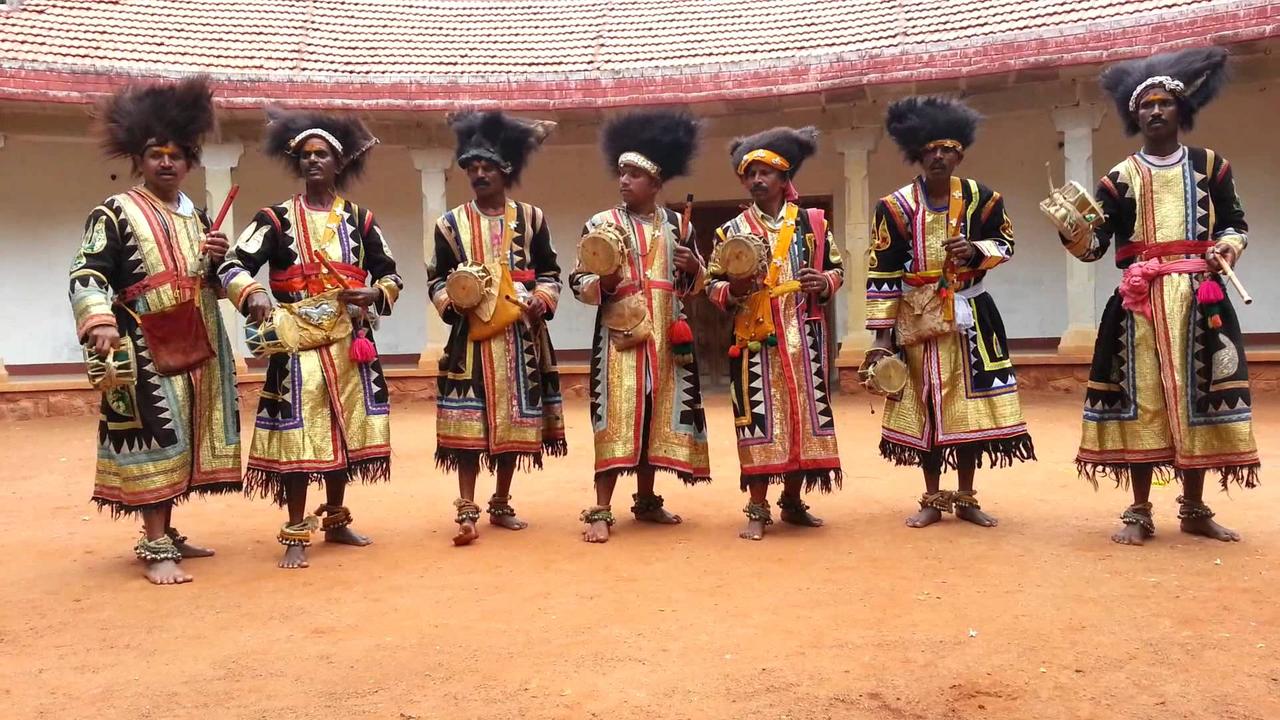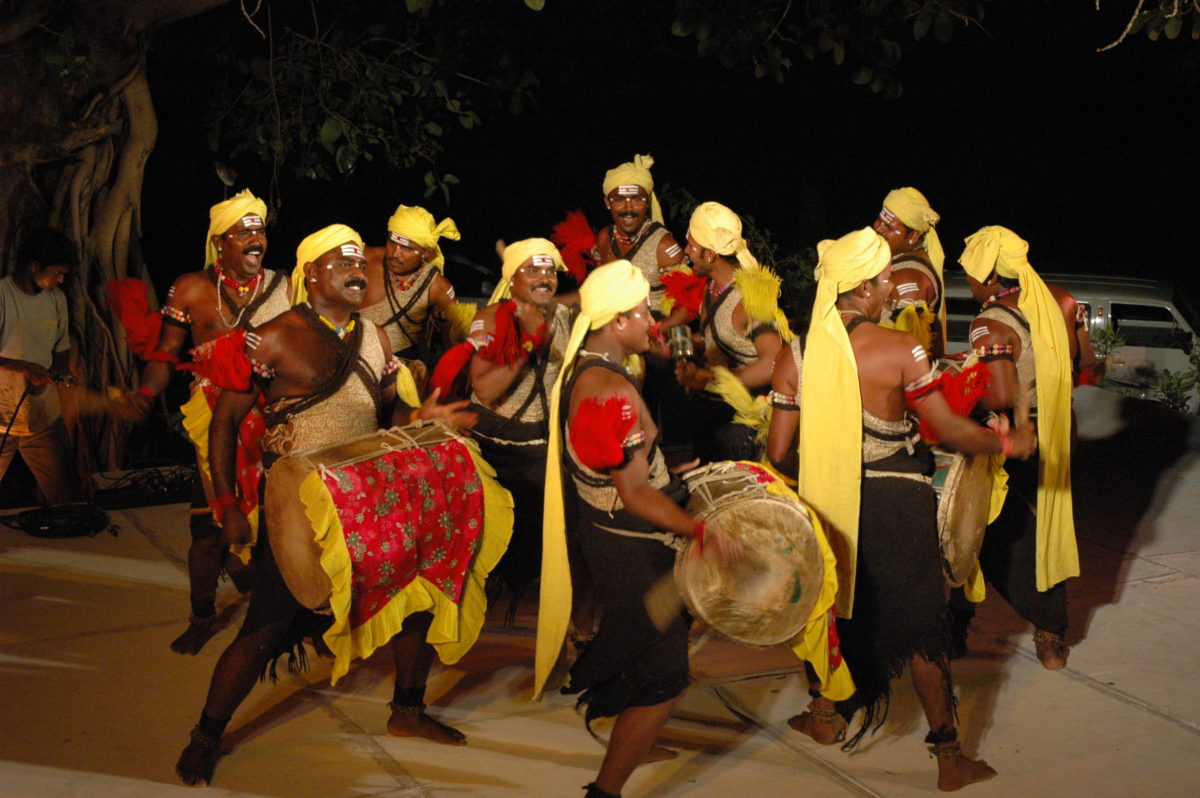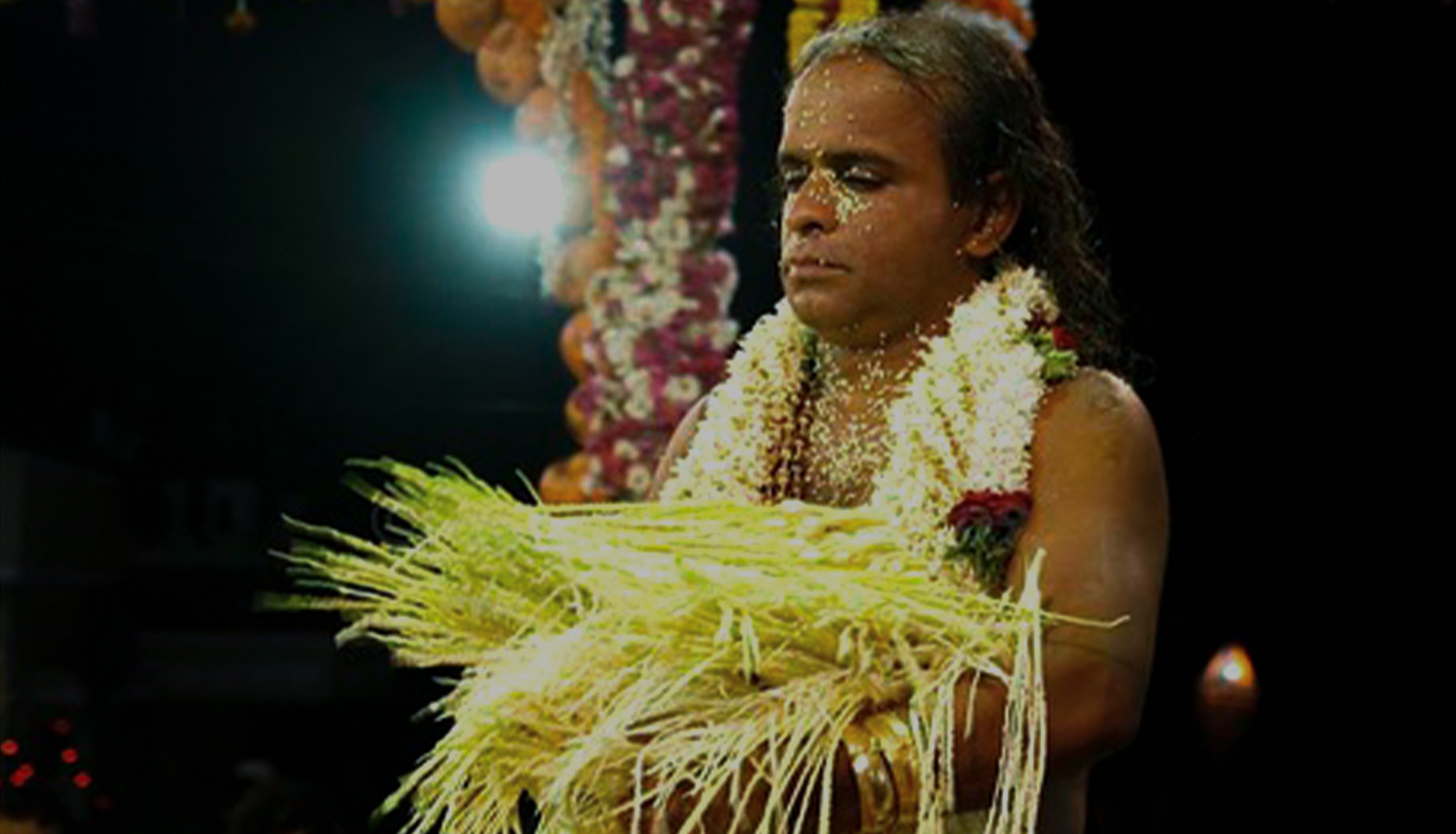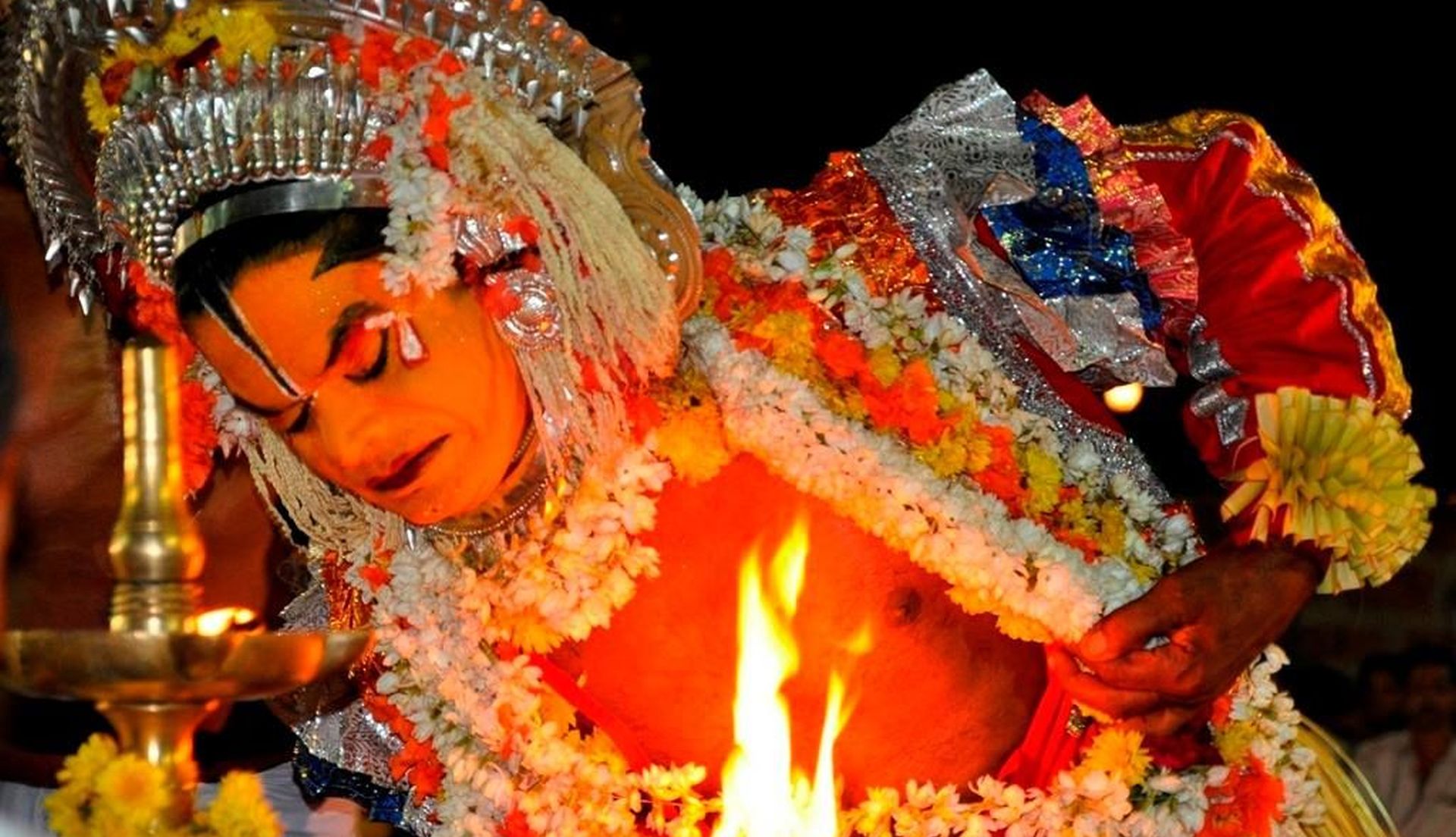Karnataka has a very rich heritage of Dances here in this blog we have tried to enumerate few of the most popular dance forms of Karnataka. Hope the readers will enjoy this compilation.
1. The Kaveri Dance and Goravara Kunitha

The kaveri dance is a ritual that celebrates the goddess Kali in the mythological world of India. Women of the Kodava community perform the dance adorned in a red silk sari, a full-sleeved Coorg blouse, and a red scarf around their head. The dance is performed to a rhythmic beat played by brass cymbals and percussion instruments.
The performance is accompanied by music played on a wind pipe, cymbals, and a drum, which is called the Nandikolu. The lead singer also narrates the epic. The dancers also wear orange flags, and a sOma – a mask that covers the head – made from a triangular piece of wood. This piece of art is adorned with brass and silver ornaments.
The performance is also a unique combination of classical and folk forms of Karnataka. The dance incorporates dance from North Eastern India and the South, and was created by Churchill Pandian, founder of Utsav Music. The cast features Astha Dixit, representing the River Ganga in Kathak, Bhavana Reddy performing the Yamuna in Kuchipudi, and Dr. Aparupa Chatterjee presenting Brahmaputra in Odissi.
The Goravara Kunitha is a traditional dance form performed by the Kuruba Gowdas of Karnataka. This dance has religious connotations and is performed during festivals. During the performance, the dancers perform trance-like movements while invoking a mystic song. The songs are sung to accompany the music of small bronze bells.
2. Dollu Kunitha and Kodava Dances

The Dollu kunitha is performed with a double-headed percussion instrument called a dollu. It has its origins in mythology. According to the story, Dollasura, an ardent devotee of Lord Shiva, met Lord Shiva, who asked him to swallow him. In anger, the dollasura swallowed Lord Shiva, who grew larger and expanded inside the dollasura’s belly. This was how the dollu was born.
The Dollu kunitha dance is a major art form in Karnataka, and it occupies a special place among folk dances. This unique dance style is accompanied by music, including singing, and provides spectacular variety and complexity in demonstration. This style of dance has a long and proud history in Karnataka, and many of the performers are descendants of the legendary Draupadi.
The Kodava dance is performed in the Kodava community and has many characteristics similar to the Dollu kunitha dance. It is performed by men in the traditional Kodava dress, and is performed in a field with a burning oil lamp. Each dancer carries a kumkuma or a short sword, which represents the spotted deer of Kodava legend. A group of Kodava men perform the dance, and the sound of percussion and wind instruments add to the overall rhythm.
Suggested Tour Packages
- Enchanting Kerala Tour
- India Tour Packages
- Golden Triangle Tour of Odisha
- Kerala Tour with Kanyakumari
- Golden Triangle Tour with Mumbai
- Golden Triangle Tour of Karnataka
3. Nagamandala Dance and Pata Kunitha

There are many ways to watch a nagamandala dance in Karnataka, including online or in a local community. Nagamandala dances are a celebration of the snake god, and the event is normally held during the summer. There is an elaborate pattern with the snake image. Whether you’re looking for a wholesome family outing, or a spiritual experience, nagamandalas will give you the most enjoyable evening of your life.
The Gaarudi Gombe is a traditional dance of Karnataka that features dancing on a dress made from bamboo sticks. It is performed during the major festivals and processions and is thought to have originated from the epic Mahabharata. In the epic, the Gaarudi Gombe pacified Satyabhama after she was angry. Today, the dance is performed in coastal regions and is performed in processions and festivals.
The nagamandala festival begins after sunset. This performance includes a variety of performers, including the musicians who play the dakke, a type of pipe instrument. The dancers move in circles around the mandala, with the nagabannika representing the female snake. This dance is performed by two priests who lead the performance. In addition to the nagamandala dance, there is also a Nagabannika festival.
Another traditional dance in Karnataka is the Pata Kunitha. This ritualistic dance is performed by two or three artists, called somas. These performers dance while manipulating a 15-foot umbrella or pole. They sway their arms and perform various rhythmic movements to create the dance. One of the key performers has white hair and a white mustache.
4. Yakshagana Dance

The yakshagana dance of Karnataka is a folk tradition that has been kept alive over the centuries. Today, the dance is performed in coastal areas and in inland regions. There are two types of yakshagana: the traditional form known as Moodalapaya and the more popular Paduvalapaya. Both are characterized by intricate patterns and percussion beats. The women perform the traditional dance in groups.
The origin of Yakshagana is unclear, but there is some evidence that it dates back a thousand years. This dance form is rooted in ancient mythology and Hindu scriptures. Its mystical and powerful performance is most often performed at night and features a cast of colorful, elaborate costumes. Performers often play different roles from the Holy Scriptures and invoking the gods for success in life and in the dance.
The movement of the Yakshagana is synchronized and coordinated, with each performer carefully watching the movements of their counterparts on stage. Although the steps for all the different characters are similar, there is some subtle variation depending on the character. A traditional Yakshagana performance has two distinct categories: male and female. Male characters focus on heroic battle movements while females focus on more graceful, elegant dance movements. The demon character, on the other hand, performs slow, broad, measured movements.
The music of the Yakshagana dance of Karnataka is composed of seven different talas, or meter patterns. Some dancers shift between two talas during the same verse. This creates variety and tempo. In addition to the seven talas, there are other variations of the tala structure. For example, one version uses an ashtatala, while another version combines the nidhana and twarita rhythm patterns.
Suggested Reading
- Famous Dance of Meghalaya
- Traditional Folk Dances of West Bengal
- Best Places to Visit in Kerala
- Famous Dance of Punjab
- Kerala Folk Dances and Dance Drama
- Folk and Classical Tamil Nadu Dance Forms
5. The Bhootha Aradhana and Hattari dance

If you’re looking for a unique way to celebrate the festival of Sankranthi, you’ve probably heard of the Bhootha Aradhana dance of Karnataka. The traditional performance includes a procession displaying idols of ghosts, drums, and firecrackers. It’s a truly memorable event, attracting tourists from all over the world.
This ancient art form originated in Karnataka more than 400 years ago, and is performed in honor of Lord Beereshwara. It consists of a group of dancers synchronized with each other in a circle, performing various dance movements. The dance is highly dynamic, and the performers wear elaborate costumes and headgear. The dancers often narrate stories from the Indian epics.
This ancient ritual features many different types of Kolams, from upper to lower caste. Kalkkuda and Kallurutti are two of the most famous Kolams. They were the architects and sisters of King Bhairavaraja, who ordered them to construct the Gomatheswara statue. When the statue was finished, the king became jealous and cut Kalkkuda’s hand. Kallurutti then demanded revenge on her brother. When the latter refused, she stabbed both her brothers, killing them both. In this way, they both died, and Bhairavaraja danced the Bhootha Aradhana dance. The Hattari dance, which originated in the Coorg region of Karnataka, is another popular form. The costumed dancers use shields and canes to dance. The steps in this dance are similar to those in the tandava style. Dancers raise their left foot while balancing their right foot. The dance is accompanied by drums, drumming, and many tricks.

